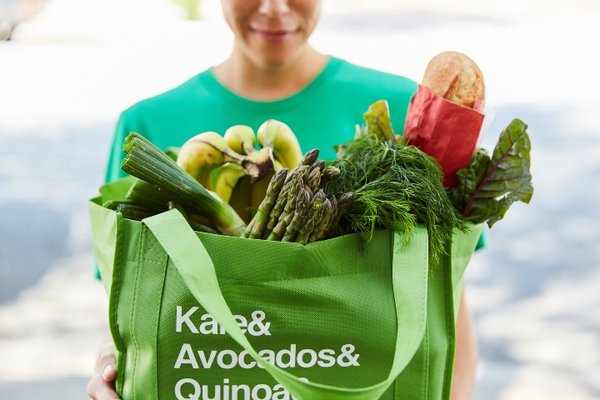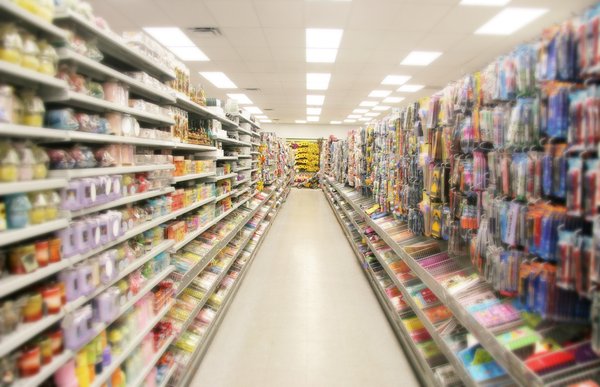You rely on consumer staples every day. They include daily essentials such as food and beverages, personal care products, and household and home care products.
People buy consumer staples regardless of the state of the economy, and the amount they buy is relatively fixed in good times and bad. In this way, the consumer staples sector behaves much differently than consumer discretionary businesses such as restaurants, hotels, and apparel, or consumer durables, which are long-lasting products such as furniture and electronics.

Consumer staples companies may not have the highest earnings growth or year-over-year revenue growth because these stocks tend to be large, mature companies, and the categories they compete in are typically developed. Historically, the sector has experienced relatively little disruption, and these stocks make up for modest growth with low price volatility, reliable profits, dividends, and defensive positioning.
Definition
What are consumer staples stocks?
Consumer staples stocks typically sell consumer goods that people use every day. These include everything from groceries, paper products, and cleaning products to over-the-counter health products, tobacco, and cosmetics. They are sometimes called fast-moving consumer goods, and the sector is also referred to as consumer defensive. These are products that are frequently consumed and turn over quickly in stores. They are also defensive because consumers buy them regardless of the state of the economy. Consumer staples are needs rather than wants.
Consumer staples stocks include both the companies that make these products and the retailers that primarily sell them like supermarkets.
Advantages
Advantages of consumer staples stocks
Consumer staples stocks function in a noncyclical manner, meaning they offer investors safety during recessionary climates. Since these companies sell goods such as food and cleaning products that consumers rely on regardless of the state of the economy, they tend to generate solid profits even in weak economies. For instance, a number of consumer staples companies thrived during the early stages of the COVID-19 pandemic as consumers stocked up on essentials and avoided spending on discretionary purchases such as travel and restaurant meals.
Consumer staples stocks also tend to be dividend payers, and many of them are even Dividend Kings, having raised their dividend payout every year for 50 years or more. That shows these companies tend to have longevity -- many of the best-known consumer staples stocks have been around for 100 years or longer -- and they're capable of steadily growing profits over a long period of time.
Consumer staples are noncyclical, meaning they offer investors safety during recessionary climates.
Because of their reputation for reliable dividends, consumer staples stocks are often popular with retirees and other investors seeking long-term income and security. Many offer better dividend yields than an S&P 500 ETF, which currently pays a dividend yield of roughly 1.2%.
Because consumer staples companies operate in stable sectors and sell products that are always in demand, the biggest ones have been around for a century or more. Their longevity is a reflection of their brand strength, their history of acquiring smaller brands, and their ability to endure a wide range of challenges and economic cycles.
One important factor to monitor when looking at a consumer staples company is its ability to pass on cost increases. Although this issue often takes center stage during inflationary periods, it is always an important component of growth. Simple price increases, changing packaging sizes, and production innovation are all vital tactics in the industry. In inflationary periods, costs for ingredients, labor, and distribution often rise faster than a company’s ability to pass on price changes. There can be a period of margin weakness that will likely be temporary for the best-managed consumer staples companies. Price increases also need to be balanced against the risk of consumers trading down to cheaper alternatives.
Best consumer staples stocks
Best consumer staples stocks to buy in 2025
Just as you’re familiar with many consumer staples products, you’ll likely be familiar with many of the top stocks in the sector, such as Procter & Gamble (PG -0.32%), PepsiCo (PEP -0.76%), Philip Morris (PM 1.52%), and Costco Wholesale (COST 0.47%).
1. Procter & Gamble
1. Procter & Gamble
Procter & Gamble is best known for its marquee brands such as Tide, Gillette, and Crest. The household and personal care company is almost 200 years old. A large number of its brands hold the No. 1 or No. 2 market share position in their categories, including paper products, laundry detergent, diapers, and beauty products. P&G is also a Dividend King.
P&G has recently developed a number of innovative products, including the nontoxic insect repellent Zevo; a dye-free, silicone-free, and sulfate-free version of Head & Shoulders called Head & Shoulders BARE; and Spruce, a weed killer, that cuts of the weed's water supply on contact. Spruce is P&G's first entry into the large lawn care category.
P&G has performed during an inflationary era since it can pass along price increases to its customers, although its growth has slowed down recently. For fiscal 2025, as of its third-quarter earnings report, the company is targeting 2% organic sales growth and 2% to 4% core earnings per share growth. Given the uncertainty around tariffs and weakening consumer sentiment, that still shows the company's ability to grow in challenging environments.
2. PepsiCo
2. PepsiCo
PepsiCo is much more than its namesake beverage brand. The company also owns Frito-Lay and Quaker, as well as popular drink brands such as Mountain Dew and Gatorade. Its Frito-Lay snack business generates almost as much revenue in North America as its beverages, and that business has been a source of growth while soda sales have slowed in the U.S. and around the world. With its global brands and distribution, Pepsi enjoys many of the same advantages as industry giants P&G and beverage company competitor Coca-Cola (KO 0.55%).
Because of its exposure to the restaurant industry, Pepsi is subject to demand in the consumer discretionary channel, but with the help of the strength of its brands, it's been able to capitalize on inflation by raising prices and growing profits. For example, in 2024 organic revenue rose 2%, driving core earnings per share (EPS) up 9%.
Pepsi has also grown through acquisitions. In 2018, it acquired SodaStream, which gave the company a leading position in countertop soda-making. It also bought energy drink maker Rockstar Energy in 2020. Earlier in 2025, it acquired Siete Foods, a maker of grain-free tortillas and Mexican-American foods, and Poppi, a prebiotic soda brand.
PepsiCo recently became a Dividend King, having raised its quarterly payout for 50 years in a row, which shows that it’s an attractive stock for income investors.
3. Philip Morris
3. Philip Morris
Philip Morris (PM 1.52%) is one of the three global tobacco giants, but the company has the strongest position of the three. Philip Morris was formed when Altria (MO 0.81%) and Philip Morris split in 2008 with Altria retaining the domestic business, while Philip Morris took the international markets.
That's proven to favor Philip Morris as international tobacco markets have been much more resilient than the U.S., where smoking has been steadily declining for decades.
In addition to its exposure to more smoking-friendly markets, Philip Morris has also outperformed peers like Altria and British American Tobacco (BTI 2.15%) in next-gen, smoke-free products, which now make up more than 40% of Philip Morris' revenue and a higher percentage of its gross profit.
The company has found success in IQOS, its heat-not-burn tobacco sticks, which uses tobacco rather than the e-liquid vapes use, and heats to a temperature where it turns into vapor rather than smoke. As of the end of 2024, there were more than 32 million IQOS users worldwide, and the number was growing. The company launched IQOS in the U.S. March 2025.
Additionally, the company's acquisition of Swedish Match in 2023 has paid off, giving it ownership of the popular Zyn oral nicotine pouches, whose shipments jumped 53% to 223.4 million cans in the first quarter of 2025. Philip Morris is also expanding production at its Kentucky Zyn facility and adding a new one in Colorado.
Finally, Philip Morris offers a reliable dividend yield of 3%.
4. Costco Wholesale
4. Costco Wholesale
Costco Wholesale has been one of the best-performing consumer staples stocks on the market in recent history.
Unlike the other stocks on the list, Costco doesn't make products for other retailers to sell. Instead, as a retailer of primarily consumer staples, more than half of its sales come from groceries.
Costco also has many of the components of a consumer staples stock that consumers look for, including a business model built around its reputation for bargain prices on bulk goods. Its membership model adds another layer of resilience since most of its profits come from membership fees. Customers typically renew memberships at a rate around 90%.
The retailer continues to open new stores and has been delivering solid comparable sales growth and e-commerce growth.
Costco also has a track record of rewarding investors with special dividends every three to five years, which makes up for its paltry dividend yield at 0.5%.
ETFs
Best consumer staples ETFs
For investors who prefer exposure to the entire consumer staples sector rather than picking individual stocks, buying shares in an exchange-traded fund (ETF) is the most sensible option. The chart below shows three consumer staples ETFs:
| Fund Name | Expense Ratio |
|---|---|
| Consumer Staples Select SPDR Fund (NYSEMKT:XLP) | 0.08% |
| Vanguard Consumer Staples ETF (NYSEMKT:VDC) | 0.09% |
| iShares U.S. Consumer Staples ETF (NYSEMKT:IYK) | 0.4% |
All three ETFs have Procter & Gamble as their No. 1 holding. PepsiCo and Coca-Cola show up in the top six while turning up lower down on two of the three lists. The iShares U.S. Consumer Staples ETF doesn't include retailers, but the other two ETFs have giants such as Walmart (WMT 0.83%) and Costco making the cut.
In addition, all three ETFs own popular consumer staples stocks such as:
Related investing topics
Are consumer staples stocks right for you?
The best consumer staples companies tend to have consistently strong organic sales, leading market shares, and attractive dividend yields. Although the industry sees relatively little innovation and growth, consumer staples products tend to be timeless, and these companies are likely to continue to endure.
Consumer staples companies have an excellent ability to withstand recessions, increase their dividends, and post consistent, incremental growth. All of those characteristics make them good choices for investors looking for reliable, income-producing stocks.
FAQ
Investing in consumer staples stocks FAQ
Is it a good time to invest in consumer staples stocks?
It's impossible to predict the short-term movements of the market, but investors tend to favor consumer staples stocks during times of uncertainty since they generally outperform in weak economies due to their defensive positioning.
What is the average annual return of consumer staples?
Determining the average annual return of consumer staples depends on how you define the sector and which stocks you choose. Based on the history of the Consumer Staples Select Sector SPDR Fund (XLP), consumer staples stocks have compounded at a 7% rate with dividends reinvested since 1998.
Should I have consumer staples in my portfolio?
Whether you should have consumer staples in your portfolio will depend on your investing style. If you are a risk-averse investor or a retiree looking for reliable dividend income, then investing in consumer staples makes sense.
If you're a growth-oriented, risk-seeking investor, you'll probably favor other sectors over consumer staples.















